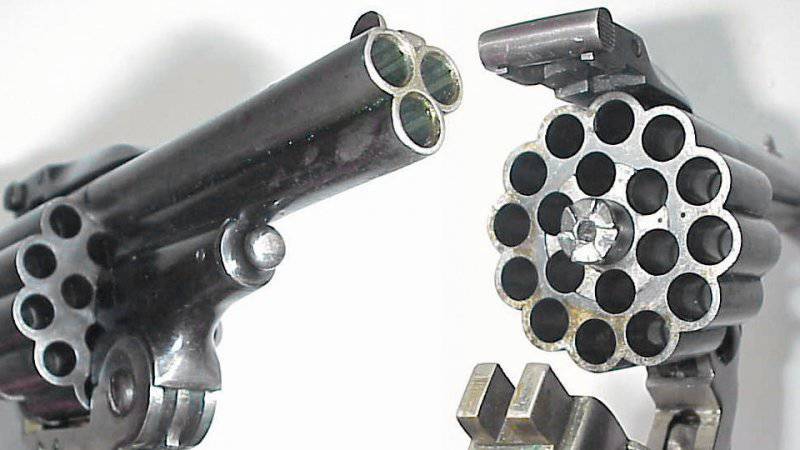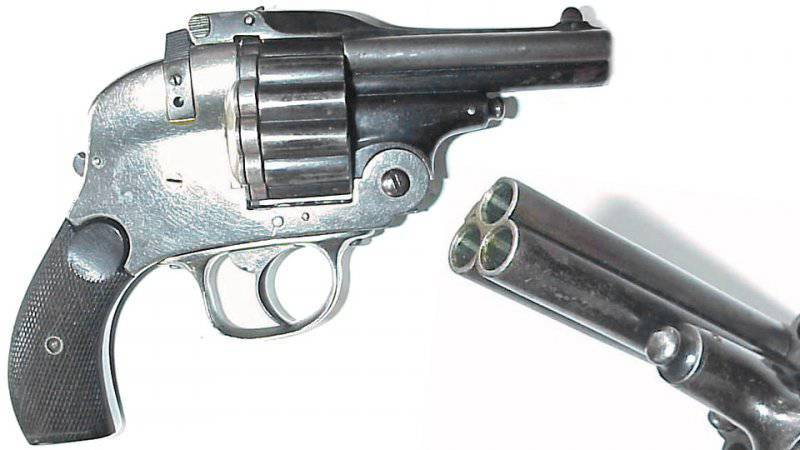Mysterious three-barreled revolver
At the beginning of the 20th century, a certain Spanish gunsmith decided to present his version of the solution to the existing problem to the world. Unfortunately, the name of this master is unknown - no paper evidence has been preserved, and the stamp on the weapon does not give an answer to the question of authorship. At the end of the 19th and the beginning of the 20th century, gunsmiths of the whole world sought to find a universal weapon scheme with all the necessary advantages. As is known from stories small arms, as a result, self-loading pistols won the most popularity. The unknown Spanish master, in turn, intended to promote the good old revolvers.
The unique three-barreled revolver, preserved in a single copy, was equipped with a 18 (!) Drum for 6,35x15 mm Browning cartridges (also known as .25 ACP). All cartridges were placed in a single drum in two rows. In the inner there were six pieces, like on “ordinary” revolvers, and the outer one contained the remaining twelve. In this case, the cartridges are grouped in three - one from the internal row and two from the external. For the extraction of spent cartridges and reloading the drum, an unknown master from Spain used a clip of the original design in his revolver. It consists of two flat parts with holes, connected by a screw. As planned by the gunsmith, the plate with holes of smaller diameter shifted relative to the plate with large turns on the axis. Then the cartridges were inserted into the larger-diameter sockets and the second plate returned to the place, preventing the cartridges from spilling out of the holder. The design of this clip can not be called simple, but it improves the usability of the gun. When manipulating the equipped holder, the shooter has almost no risk of spilling ammunition and doing less useful things instead of firing.
The drum of the revolver, as follows from its design, does not imply the movement of cartridges by other means except turning the drum itself. Accordingly, the double-row drum does not allow full use of ammunition, having only one barrel. In the Spanish revolver, the cartridges were arranged in two rows, and in addition, they were combined into “sector” groups of three. Thus, the design of the drum itself required the use of three trunks at once. Three rifled barrel caliber 6,35 mm and a length of three inches (7,62 cm) were assembled in one package and fixed on the axis. Thus, for reloading the revolver, it was necessary to unblock the swinging unit and “break” the barrels and the drum forward-down. Then, using the extractor button, the holder was removed with the cartridge cases and a new one was installed in its place.
It is obvious that the use of three trunks and a specific drum at once required a serious refinement of the classic double-action firing mechanism. First, the three-barreled revolver received three drummers, one for each barrel. The mechanics of the gun did not allow him to shoot at the same time from all three barrels. To select a shooting barrel on the top of the frame of the revolver, directly above the strikers, there is a special movable switch. When he is in the middle position, the force from the trigger is transmitted to the drummer and the mainspring of the lower barrel. When the “translator of fire” is moved to the leftmost position, shooting is fired from the upper left barrel, while moving to the right, respectively, from the upper right. For safety, the USM has a manual fuse. His flag is displayed on the back of the revolver.
Due to the design of the drum and barrel assembly, the revolver has dimensions and proportions uncharacteristic for this class of weapon. Yes, and the weight of the design is quite large - a triple-barreled revolver weighs just over a kilogram. Among other things, such weight and size parameters are due to the materials used in the construction. Thus, the main part of the frame in which the trigger is placed is made of nickel-plated steel. The barrel block and the drum are also steel, but are blued. The handle of the revolver for a tighter "seat" in the hand has lining of hard rubber with grooved.
Unfortunately, almost nothing is known about the unique three-bar revolver, apart from the peculiarities of its design. There is information that it was made in the period from 1910 to 1920 year and made just one copy. Of all the signs by which one could learn about the origin of the revolver, there is only an inscription on the upper surface of the block of barrels. The inscription “PISTOLA_CONCARICATOJI_CAL.6.36” is stamped on a narrow strip. From this inscription with full confidence you can make only the caliber of a revolver and the country of origin (the inscription is similar to Spanish), but not the author. Currently, the only copy of the three-barreled "Pistola Concaricatoji" is in the museum exhibition. No other revolvers of the same type have yet been discovered, and the most popular version of the origin of this revolver states that an unknown master managed to make only one copy. Perhaps the tests of the first revolver failed to confirm the advantages of the applied scheme. And perhaps, for some reason, the master simply could not continue his work. Anyway, at the moment only one sample of the tri-bar revolver is known, although from time to time at various auctions there appear replicas made in recent years.
On the materials of the sites:
http://dailytechinfo.org/
http://warfiles.ru/
http://horstheld.com/


Information